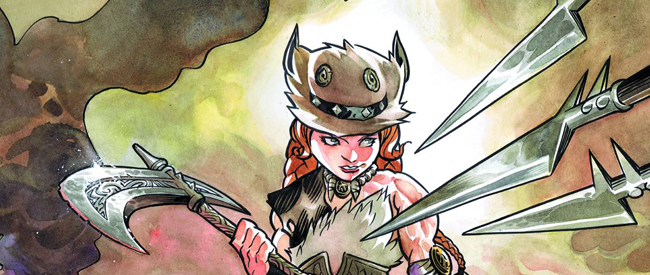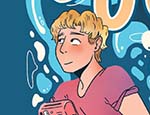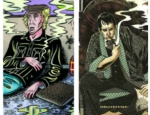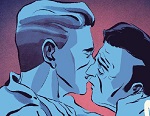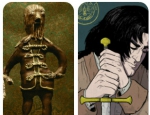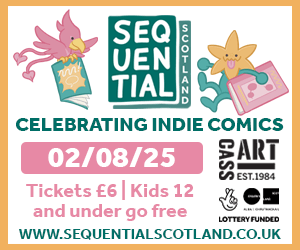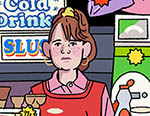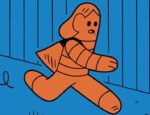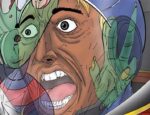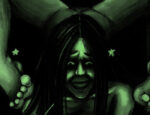If there’s a perception in the comic industry that there are aren’t enough characters that serve as role models for young, female readers, none of the blame should be placed on Ted Naifeh’s shoulders.
He’s the creator of a number of female heroes, including Courtney Crumrin, a young girl who learns magic from her mysterious uncle and uses it to navigate the troubling world of adolescence, and Polly Pringle, who becomes the captain of a pirate ship in the adventures of Polly & the Pirates.
Ted’s latest series, Princess Ugg (published by Oni Press), challenges the notion of what it means to be a princess, as Ülga, the heiress to a barbarian throne, decides to attend an academy with other young royals from the kingdom of Atraesca.
The first two issues of Princess Ugg have already been released and have received rave reviews. The third issue comes out on August 13, making it a perfect time to chat with Ted about this new series and his career in comics.
In your new comic, Princess Ugg, the main character Ülga doesn’t fit the way we’re used to seeing princesses look or behave. In what was are you using this story to challenge the preconceived notions of what it means to be a princess?
Ted Naifeh: Great question. With Princess Ülga, I wanted a character that completely contradicts every mannerism we associate with princesses, to accentuate the fact that a princess isn’t actually a set of behavior patterns. If I have a conscious intention with this story, beyond it just being fun, it’s to deconstruct the whole “princess” concept.
Young girls are inundated with this flavor of über-femininity, to the point where they feel like it’s the measure of their femaleness. My sister-in-law would lament that her daughter – my niece – worried she wasn’t pretty enough to be a princess. She was maybe four years old.
That’s not something I think a toddler should be worrying about. So I wanted to offer an alternate view of what a princess is supposed to be, poke fun at the tropes, and have fun in the process.
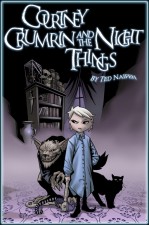 With Courtney Crumrin, Polly & the Pirates and now Princess Ugg, you seems to have a pattern of creating young, female lead characters, which happen to be something the comic and entertainment industry is sorely lacking. Is this an issue you’re specifically trying to address with these titles?
With Courtney Crumrin, Polly & the Pirates and now Princess Ugg, you seems to have a pattern of creating young, female lead characters, which happen to be something the comic and entertainment industry is sorely lacking. Is this an issue you’re specifically trying to address with these titles?
Well, to start with, as you point out, there was a massive gap in the market and a swelling audience starved of that kind of material. That just seemed like good business sense.
Plus, being raised on superheroes in general, my sense of justice is aggravated by the continued, clearly calculated lack of representation of women in comics. Not to mention the complete vacuum where there used to be comics for kids under 18.
Of course, as a 14-year-old myself, I fell in love with comics for the very material, by Alan Moore, Matt Wagner, Frank Miller etc, that has ultimately crowded out everything else. But it doesn’t change the fact that it was an underserved market, and slipping in there seemed like a smart move.
Plus, I’ve always felt a deep and profound connection to children’s stories and the effect they can have on young readers. My fondest memories from that time came from the sense of hope I felt reading books about kids having adventures and triumphing, partly over their own problematic tendencies. That to me was inspiring. I don’t think there’s enough of that in the modern comics for “adults.”
Have you found that your audience follows you from one title to the next, or does each title appeal to its own particular audience?
They follow me around. That’s a great perk of being an indie creator and not depending on the previously established popularity of the character you’re working on.
Most of my fans preferred Courtney to Polly, but I think that is due in part to the fact that Courtney has so much more story. That makes a difference. But Polly has her fair share of fans, some of whom don’t even particularly like Courtney. For two young blond girls, they’re very different flavors, and their stories couldn’t be much more opposite.
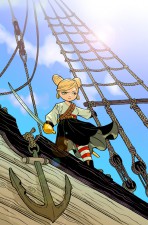 You wrote and illustrated the first series of Polly & the Pirates, but for the second volume you collaborated with artist Robbi Rodriguez. What made you decide to bring in another artist and what was it like seeing your character drawn by another artist?
You wrote and illustrated the first series of Polly & the Pirates, but for the second volume you collaborated with artist Robbi Rodriguez. What made you decide to bring in another artist and what was it like seeing your character drawn by another artist?
The main reason was that I didn’t have time to do it myself. I was working on a series for Scholastic called The Good Neighbors, written by New York Times best-selling author Holly Black. It was hard to let go, and sometimes I still feel pangs that I didn’t get a chance to draw it myself. But there’s only so much time, and I need to have a life too.
It was also hard seeing my character in the hands of another artist, partly because he didn’t do things the way I would have, which could be frustrating, and partly because he tried things I never thought of, which was frustrating in a totally different way. Robbi has a handle on dynamic panel progression and action I can’t even touch. And at the end of the day, it worked out great having a fresh take on the character.
How Loathsome was an adult-themed graphic novel you drew about the queer underworld of San Francisco. It was an amazing achievement and quite different from the other comics you have worked on. Did you enjoy the change of pace, and how did the subject matter affect your artistic approach to the book?
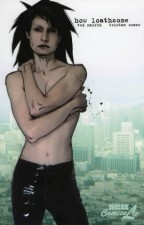 To be honest, I was still trying to figure out what kind of creator I wanted to be, and How Loathsome gave me the chance to flex different muscles creatively, as well as letting me explore subject matter that’s less mainstream, and more “me.”
To be honest, I was still trying to figure out what kind of creator I wanted to be, and How Loathsome gave me the chance to flex different muscles creatively, as well as letting me explore subject matter that’s less mainstream, and more “me.”
To be perfectly honest, I kind of have to rein myself in most of the time doing comics for tweens and teens, and How Loathsome was a chance to cut loose and not censor myself.
On the other hand, my philosophy when creating art is always to try to meet the audience where they are, and let them into my worlds, rather then impose them like some kind of dogma and expect readers to come all the way to me.
I think How Loathsome‘s greatest triumph is that it is simple and accessible. It’s totally out there, but it’s not trying to be pretentious, nor is it a book for insiders only. Plus, because there were all sorts of different stories in it, I got the chance to experiment with different art styles, and that was a real joy. It’s so much fun to reinvent my art style for eight pages.
This year marks the 15th anniversary of your first major comic, Gloomcookie, a series you co-created with Serena Valentino. You two have plans to reprint it as a hardcover. What can you tell us about its progress and your plans to fund it through Kickstarter?
Kickstarter is a full-time job, and neither I nor Serena have enough time to plunge in, so it’s taking a little time. Right now we’re getting the pieces of the video pitch together, which will include testimonials from various important folks. It’s coming along. I will have more details as they come.
Before we go, is there anything you want to tell us about the future of Princess Ugg? Do you have a specific length in mind for the series or are you going to see how it develops along the way?
The first story arc will be eight issues. After that, if the book is a success, I will do another eight-issue arc, and hopefully eventually two more. I don’t like stories to wear out their welcome or to go longer than they want.
I find that stories open with a natural ending written into their DNA. They ask a question and demand an answer. If you take too long getting there, or have no idea what the answer is, or, as is the case with so much modern media, forget what the question was in the first place, you’ve wasted your readers’ time.
As a reader, I often get discouraged with comics, knowing that they’ll never answer even the most fundamental questions of their stories and I’ll be left unfulfilled. So I always try to know where I’m going when I launch a story. Maybe that means my stories are predictable, but I haven’t had any complaints yet.
You can see more of Ted Naifeh’s work on his website, and be sure to pick up Princess Ugg (Oni Press), with #3 out on August 13.





